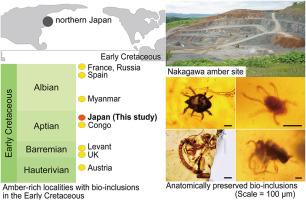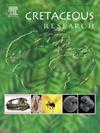A new amber Lagerstätte from the Lower Cretaceous of Japan
IF 1.7
3区 地球科学
Q1 GEOLOGY
引用次数: 0
Abstract
During the Early Cretaceous, terrestrial ecosystems underwent a critical transition driven by the emergence and diversification of angiosperms. Amber-rich deposits from this period are crucial for understanding the diversity, interactions, and evolution of terrestrial biota. However, their occurrences are limited both geographically and stratigraphically. Here, we report a new amber Lagerstätte from the upper Aptian (116–114 Ma) in northern Hokkaido, Japan. The abundant amber occurs within deep-sea deposits and is rich in bio-inclusions: arthropods (hymenopterans, mites), fungi, and plant remains (tracheids, stellate hairs, pollen grains), with submicron-scale morphological details. This is the first report of fossiliferous amber-rich deposits from the Aptian in Asia. It is also recognized as one of the older amber-rich localities with bio-inclusions following those in northeastern Italy (Carnian, Upper Triassic), the Levantine area (Tithonian, Upper Jurassic; Barremian), Austria (Hauterivian), the United Kingdom (lower Barremian), and southern Congo (upper Aptian). This finding fills a paleobiogeographical gap in fossil record and provides anatomical and ecological insights into a critical interval marked by the rise of modern-type forest ecosystems.

日本下白垩纪发现的新琥珀Lagerstätte
在白垩纪早期,被子植物的出现和多样化推动了陆地生态系统的关键转变。这一时期的富含琥珀的沉积物对了解陆地生物群的多样性、相互作用和进化至关重要。然而,它们的出现在地理和地层上都是有限的。本文报道了在日本北海道北部Aptian上(116-114 Ma)发现的一种新琥珀Lagerstätte。丰富的琥珀存在于深海沉积物中,富含生物包裹体:节肢动物(膜翅目动物、螨虫)、真菌和植物遗骸(管状体、星状毛、花粉粒),具有亚微米尺度的形态细节。这是亚洲阿普tian地区首次发现富含琥珀的化石矿床。它也被认为是继意大利东北部(卡尼期,上三叠世),地中海地区(梯东期,上侏罗纪,巴雷米期),奥地利(Hauterivian),英国(下巴雷米期)和刚果南部(上阿普tian)之后最古老的富含琥珀的地区之一。这一发现填补了化石记录中的古生物地理学空白,并为现代森林生态系统兴起的关键时期提供了解剖学和生态学的见解。
本文章由计算机程序翻译,如有差异,请以英文原文为准。
求助全文
约1分钟内获得全文
求助全文
来源期刊

Cretaceous Research
地学-地质学
CiteScore
4.10
自引率
19.00%
发文量
235
审稿时长
12 weeks
期刊介绍:
Cretaceous Research provides a forum for the rapid publication of research on all aspects of the Cretaceous Period, including its boundaries with the Jurassic and Palaeogene. Authoritative papers reporting detailed investigations of Cretaceous stratigraphy and palaeontology, studies of regional geology, and reviews of recently published books are complemented by short communications of significant new findings.
Papers submitted to Cretaceous Research should place the research in a broad context, with emphasis placed towards our better understanding of the Cretaceous, that are therefore of interest to the diverse, international readership of the journal. Full length papers that focus solely on a local theme or area will not be accepted for publication; authors of short communications are encouraged to discuss how their findings are of relevance to the Cretaceous on a broad scale.
Research Areas include:
• Regional geology
• Stratigraphy and palaeontology
• Palaeobiology
• Palaeobiogeography
• Palaeoceanography
• Palaeoclimatology
• Evolutionary Palaeoecology
• Geochronology
• Global events.
 求助内容:
求助内容: 应助结果提醒方式:
应助结果提醒方式:


